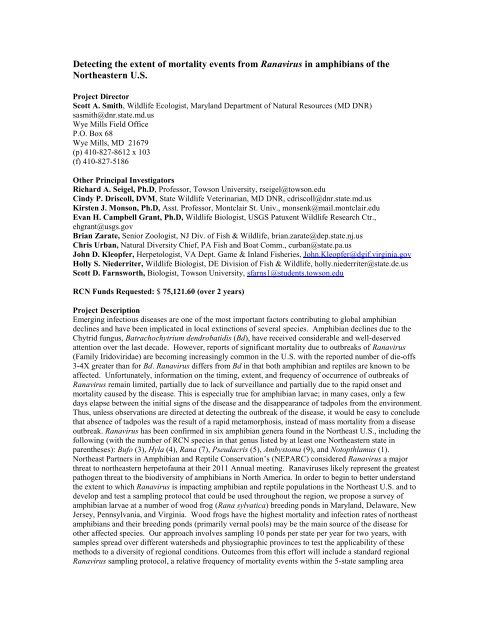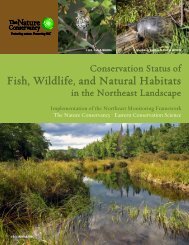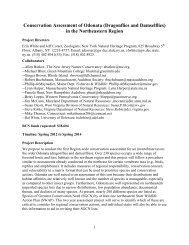RCN 2012(1) Ranavirus in amphibians.pdf
RCN 2012(1) Ranavirus in amphibians.pdf
RCN 2012(1) Ranavirus in amphibians.pdf
You also want an ePaper? Increase the reach of your titles
YUMPU automatically turns print PDFs into web optimized ePapers that Google loves.
Detect<strong>in</strong>g the extent of mortality events from <strong>Ranavirus</strong> <strong>in</strong> <strong>amphibians</strong> of the<br />
Northeastern U.S.<br />
Project Director<br />
Scott A. Smith, Wildlife Ecologist, Maryland Department of Natural Resources (MD DNR)<br />
sasmith@dnr.state.md.us<br />
Wye Mills Field Office<br />
P.O. Box 68<br />
Wye Mills, MD 21679<br />
(p) 410-827-8612 x 103<br />
(f) 410-827-5186<br />
Other Pr<strong>in</strong>cipal Investigators<br />
Richard A. Seigel, Ph.D, Professor, Towson University, rseigel@towson.edu<br />
C<strong>in</strong>dy P. Driscoll, DVM, State Wildlife Veter<strong>in</strong>arian, MD DNR, cdriscoll@dnr.state.md.us<br />
Kirsten J. Monson, Ph.D, Asst. Professor, Montclair St. Univ., monsenk@mail.montclair.edu<br />
Evan H. Campbell Grant, Ph.D, Wildlife Biologist, USGS Patuxent Wildlife Research Ctr.,<br />
ehgrant@usgs.gov<br />
Brian Zarate, Senior Zoologist, NJ Div. of Fish & Wildlife, brian.zarate@dep.state.nj.us<br />
Chris Urban, Natural Diversity Chief, PA Fish and Boat Comm., curban@state.pa.us<br />
John D. Kleopfer, Herpetologist, VA Dept. Game & Inland Fisheries, John.Kleopfer@dgif.virg<strong>in</strong>ia.gov<br />
Holly S. Niederriter, Wildlife Biologist, DE Division of Fish & Wildlife, holly.niederriter@state.de.us<br />
Scott D. Farnsworth, Biologist, Towson University, sfarns1@students.towson.edu<br />
<strong>RCN</strong> Funds Requested: $ 75,121.60 (over 2 years)<br />
Project Description<br />
Emerg<strong>in</strong>g <strong>in</strong>fectious diseases are one of the most important factors contribut<strong>in</strong>g to global amphibian<br />
decl<strong>in</strong>es and have been implicated <strong>in</strong> local ext<strong>in</strong>ctions of several species. Amphibian decl<strong>in</strong>es due to the<br />
Chytrid fungus, Batrachochytrium dendrobatidis (Bd), have received considerable and well-deserved<br />
attention over the last decade. However, reports of significant mortality due to outbreaks of <strong>Ranavirus</strong><br />
(Family Iridoviridae) are becom<strong>in</strong>g <strong>in</strong>creas<strong>in</strong>gly common <strong>in</strong> the U.S. with the reported number of die-offs<br />
3-4X greater than for Bd. <strong>Ranavirus</strong> differs from Bd <strong>in</strong> that both amphibian and reptiles are known to be<br />
affected. Unfortunately, <strong>in</strong>formation on the tim<strong>in</strong>g, extent, and frequency of occurrence of outbreaks of<br />
<strong>Ranavirus</strong> rema<strong>in</strong> limited, partially due to lack of surveillance and partially due to the rapid onset and<br />
mortality caused by the disease. This is especially true for amphibian larvae; <strong>in</strong> many cases, only a few<br />
days elapse between the <strong>in</strong>itial signs of the disease and the disappearance of tadpoles from the environment.<br />
Thus, unless observations are directed at detect<strong>in</strong>g the outbreak of the disease, it would be easy to conclude<br />
that absence of tadpoles was the result of a rapid metamorphosis, <strong>in</strong>stead of mass mortality from a disease<br />
outbreak. <strong>Ranavirus</strong> has been confirmed <strong>in</strong> six amphibian genera found <strong>in</strong> the Northeast U.S., <strong>in</strong>clud<strong>in</strong>g the<br />
follow<strong>in</strong>g (with the number of <strong>RCN</strong> species <strong>in</strong> that genus listed by at least one Northeastern state <strong>in</strong><br />
parentheses): Bufo (3), Hyla (4), Rana (7), Pseudacris (5), Ambystoma (9), and Notopthlamus (1).<br />
Northeast Partners <strong>in</strong> Amphibian and Reptile Conservation’s (NEPARC) considered <strong>Ranavirus</strong> a major<br />
threat to northeastern herpetofauna at their 2011 Annual meet<strong>in</strong>g. <strong>Ranavirus</strong>es likely represent the greatest<br />
pathogen threat to the biodiversity of <strong>amphibians</strong> <strong>in</strong> North America. In order to beg<strong>in</strong> to better understand<br />
the extent to which <strong>Ranavirus</strong> is impact<strong>in</strong>g amphibian and reptile populations <strong>in</strong> the Northeast U.S. and to<br />
develop and test a sampl<strong>in</strong>g protocol that could be used throughout the region, we propose a survey of<br />
amphibian larvae at a number of wood frog (Rana sylvatica) breed<strong>in</strong>g ponds <strong>in</strong> Maryland, Delaware, New<br />
Jersey, Pennsylvania, and Virg<strong>in</strong>ia. Wood frogs have the highest mortality and <strong>in</strong>fection rates of northeast<br />
<strong>amphibians</strong> and their breed<strong>in</strong>g ponds (primarily vernal pools) may be the ma<strong>in</strong> source of the disease for<br />
other affected species. Our approach <strong>in</strong>volves sampl<strong>in</strong>g 10 ponds per state per year for two years, with<br />
samples spread over different watersheds and physiographic prov<strong>in</strong>ces to test the applicability of these<br />
methods to a diversity of regional conditions. Outcomes from this effort will <strong>in</strong>clude a standard regional<br />
<strong>Ranavirus</strong> sampl<strong>in</strong>g protocol, a relative frequency of mortality events with<strong>in</strong> the 5-state sampl<strong>in</strong>g area
which can be extrapolated to a regional perspective, a summary of known or suspected <strong>Ranavirus</strong> events <strong>in</strong><br />
the 13 northeastern states, and publications <strong>in</strong> peer-reviewed scientific journals.<br />
Priority <strong>RCN</strong> Topic, Geographic Coverage, and Period<br />
This project addresses Priority <strong>RCN</strong> Topic # 7- Identify and Assess Threats to NE Species of Greatest<br />
Conservation Need. <strong>Ranavirus</strong> is a potential direct threat to at least 29 <strong>RCN</strong> amphibian species found <strong>in</strong><br />
the Northeast U.S., as well as an <strong>in</strong>creas<strong>in</strong>g number of reptile species. This project will be conducted <strong>in</strong><br />
Maryland, Delaware, New Jersey, Pennsylvania and Virg<strong>in</strong>ia, however the survey protocols developed can<br />
be applied to any state <strong>in</strong> the region (and with<strong>in</strong> the geographic range of the wood frog). <strong>Ranavirus</strong> has<br />
been detected <strong>in</strong> herpetofauna <strong>in</strong> 7 states <strong>in</strong> the Northeast (MA, ME, MD, NH, NJ, PA, VA) but likely<br />
occurs <strong>in</strong> all. The study period is for the 2013 and 2014 breed<strong>in</strong>g seasons; thus the project will start <strong>in</strong><br />
January 2013, cont<strong>in</strong>gent on availability of fund<strong>in</strong>g, and run through December 2014 (<strong>in</strong>clud<strong>in</strong>g data<br />
analysis and report writ<strong>in</strong>g).<br />
Goals and Objectives<br />
The goal of this project is to better understand the extent to which <strong>Ranavirus</strong> is impact<strong>in</strong>g amphibian and<br />
reptile populations <strong>in</strong> the Mid-Atlantic and to develop and test a sampl<strong>in</strong>g protocol that could be used<br />
throughout the Northeast region. This will be accomplished by focus<strong>in</strong>g on sampl<strong>in</strong>g at wood frog breed<strong>in</strong>g<br />
ponds (vernal pools), with the order of priority as those sites at or nearest to where <strong>Ranavirus</strong> is known or<br />
suspected to have occurred <strong>in</strong> any amphibian or reptile species. Mortality rates are 50-99% <strong>in</strong> the larval life<br />
stage compared to low mortality rates <strong>in</strong> adults; thus larvae are the appropriate life stage to sample to<br />
<strong>in</strong>crease the probability of detection of the disease. We will accomplish these goals through the follow<strong>in</strong>g<br />
objectives:<br />
1. In consultation with the National Wildlife Health Center, state wildlife health labs, state and<br />
federal fish and wildlife agencies, universities, and local experts identify exact locations where<br />
<strong>Ranavirus</strong> has been confirmed or is suspected <strong>in</strong> the five study states.<br />
2. In consultation with state and federal fish and wildlife agencies, universities, and local experts<br />
identify exact locations of wood frog breed<strong>in</strong>g ponds <strong>in</strong> the five study states, choose a subset to<br />
survey, ga<strong>in</strong> permission to survey them, and secure state scientific collect<strong>in</strong>g and endangered<br />
species permits to collect animals from these sites.<br />
3. In consultation with state and federal fish and wildlife agencies, universities, and local experts<br />
identify one qualified local <strong>in</strong>dividual <strong>in</strong> each state to be used as a seasonal technician for the field<br />
sampl<strong>in</strong>g portion of this study.<br />
4. Adaptively manage sampl<strong>in</strong>g protocol based on logistical challenges and <strong>in</strong>put from field<br />
personnel.<br />
5. In consultation with the National Wildlife Health Center and Montclair State University develop<br />
an efficient system for rapid shipment of animal samples to their labs for <strong>Ranavirus</strong> detection<br />
analysis.<br />
6. Review pathology results from the National Wildlife Health Center and Montclair State<br />
University.<br />
7. Prepare annual and f<strong>in</strong>al reports of our f<strong>in</strong>d<strong>in</strong>gs, <strong>in</strong>clud<strong>in</strong>g maps of study areas and sites of past<br />
and current <strong>Ranavirus</strong> outbreaks <strong>in</strong> the 5-state study region.<br />
8. Through a questionnaire sent to states, review of scientific literature, and consultation with the<br />
National Wildlife Health Center, develop a summary of all known and suspected <strong>Ranavirus</strong> events<br />
<strong>in</strong> the 13 northeastern states and determ<strong>in</strong>e which states are actively sampl<strong>in</strong>g for this disease.<br />
9. Present study f<strong>in</strong>d<strong>in</strong>gs at regional and national professional scientific meet<strong>in</strong>gs and on appropriate<br />
websites.<br />
10. Publish results <strong>in</strong> peer-reviewed scientific journals, <strong>in</strong>clud<strong>in</strong>g dissem<strong>in</strong>ation of recommended<br />
sampl<strong>in</strong>g protocol to be used throughout the region.<br />
2
Methodology and Approach<br />
1. Select Study Ponds: The National Wildlife Health Center, state wildlife health labs, state and federal<br />
fish and wildlife agencies, universities, and local experts will be contacted to obta<strong>in</strong> exact locations of<br />
confirmed or expected <strong>Ranavirus</strong> <strong>in</strong>fections <strong>in</strong> each state as well as locations of known wood frog breed<strong>in</strong>g<br />
ponds. Ponds will be selected <strong>in</strong> order of highest priority from those with known or suspected disease<br />
issues, to those nearest to sites with known or suspected disease issues, to random ponds based on presence<br />
of wood frog populations. Study ponds will be ≥ 3 km apart to ensure <strong>in</strong>dependence. In each state, we will<br />
attempt to choose 10 study ponds <strong>in</strong> total from at least three different watersheds, and across the five states<br />
they will be picked to ensure sampl<strong>in</strong>g <strong>in</strong> a diversity of physiographic prov<strong>in</strong>ces representative of the entire<br />
region, such as the coastal pla<strong>in</strong>, piedmont, valley and ridge, Blue Ridge, and Appalachian plateau. A new<br />
set of study ponds may be chosen <strong>in</strong> Year 2 depend<strong>in</strong>g on results from Year 1, for a potential of 100 study<br />
ponds sampled over the 2-year study.<br />
2. Sampl<strong>in</strong>g at Study Ponds: Start<strong>in</strong>g <strong>in</strong> February 2013, wood frog larvae at Gosner stage 27 through<br />
metamorphosis (65-130 days post-hatch<strong>in</strong>g) will be sampled every 2-4 days by dip-net at each of the 10<br />
study ponds <strong>in</strong> each state. Sampl<strong>in</strong>g will <strong>in</strong>volve 5-meter l<strong>in</strong>ear dip-net sweeps along the pond bottom<br />
around the pond perimeter <strong>in</strong> each of the card<strong>in</strong>al directions (4) and two 5-meter sweeps <strong>in</strong> the central<br />
(deeper) pond area. Captured larvae will be placed <strong>in</strong> a wet bucket or tray after each sweep and sorted by<br />
species. Larvae will be visually exam<strong>in</strong>ed for <strong>in</strong>dications of ranaviral <strong>in</strong>fection (redden<strong>in</strong>g of their ventral<br />
sk<strong>in</strong>, especially around the base of the h<strong>in</strong>d limbs and the vent open<strong>in</strong>g). If no symptoms are observed all<br />
larvae will be released alive back <strong>in</strong>to the study pond. All boots, equipment and dip-nets will be<br />
dis<strong>in</strong>fected between sites <strong>in</strong> a 10% bleach solution to ensure no disease transmission between study sites.<br />
3. Sampl<strong>in</strong>g at Study Ponds where Potential Ranaviral Infection is Detected: Attempts will be made to<br />
collect ~30 larvae (live & recently dead) per potentially <strong>in</strong>fected species per site. Samples will be<br />
organized, secured and labeled follow<strong>in</strong>g National Wildlife Health Center protocol for specimen collection<br />
and all specimens will be placed <strong>in</strong> a cooler and then shipped with<strong>in</strong> 24 hours to either the USGS National<br />
Wildlife Health Center (Madison, WI) or to the Department of Biology and Molecular Biology at Montclair<br />
State University (Montclair, NJ) for full pathological screen<strong>in</strong>g (necropsies, histology of major organs, and<br />
viral, fungal and bacterial cultures where appropriate). Infected ponds will be surveyed at the same or<br />
greater frequency as all non-<strong>in</strong>fected ponds through metamorphosis to observe the length of time of the dieoff<br />
and if any animals survive. Additional samples may be collected throughout the chronology of the<br />
disease event, based on consultation with the National Wildlife Health Center. All <strong>in</strong>fected ponds found <strong>in</strong><br />
Year 1 will also be surveyed <strong>in</strong> Year 2 to determ<strong>in</strong>e persistence of the virus at the site.<br />
Wood frog tadpole <strong>in</strong>fected with <strong>Ranavirus</strong>. Eastern box turtle suffer<strong>in</strong>g from <strong>Ranavirus</strong> <strong>in</strong>fection.<br />
Montgomery County, Maryland, 2011 Montgomery County, Maryland, 2011<br />
Photo by Scott Farnsworth Photo by Scott Farnsworth<br />
3
4. Develop a summary of all known and suspected <strong>Ranavirus</strong> event s <strong>in</strong> the 13 Northeast states: The<br />
National Wildlife Health Center, state wildlife health labs, state and federal fish and wildlife agencies,<br />
universities, and local experts will be contacted to obta<strong>in</strong> <strong>in</strong>formation on confirmed or suspected <strong>Ranavirus</strong><br />
<strong>in</strong>fections <strong>in</strong> each state with<strong>in</strong> the northeast region. A questionnaire will be developed and sent to state<br />
herpetologists to determ<strong>in</strong>e if any active sampl<strong>in</strong>g for <strong>Ranavirus</strong> is ongo<strong>in</strong>g or has occurred <strong>in</strong> the recent<br />
past. Date requested will <strong>in</strong>clude: affected species, estimated mortality <strong>in</strong> numbers of <strong>in</strong>dividuals, lab<br />
diagnosis (if available), date of occurrence (to determ<strong>in</strong>e if seasonality if <strong>in</strong>fections), and county of<br />
occurrence.<br />
Products<br />
Expected outcomes from this study <strong>in</strong>clude:<br />
1. Recommendations for a standardized protocol to determ<strong>in</strong>e the extent of <strong>Ranavirus</strong>-associated dieoffs<br />
that could be applied throughout the northeastern U.S.<br />
2. A summary of states <strong>in</strong> the northeast with documented <strong>Ranavirus</strong> and those who are sampl<strong>in</strong>g for<br />
this disease.<br />
3. Publication of one or more scientific papers <strong>in</strong> peer-reviewed journals.<br />
4. Present f<strong>in</strong>d<strong>in</strong>gs at regional and national professional scientific meet<strong>in</strong>gs.<br />
5. Put results on website for broader dissem<strong>in</strong>ation, such as the Global <strong>Ranavirus</strong> Consortium<br />
(http://fwf.ag.utk.edu/mgray/ranavirus/<strong>Ranavirus</strong>.htm).<br />
Personnel (MD DNR) 1a<br />
Fr<strong>in</strong>ge Benefits (MD DNR) 1b<br />
Contractual Service 2a<br />
Fr<strong>in</strong>ge Benefits 2b<br />
Indirect Costs 3<br />
Supplies and Materials 4<br />
Travel 5<br />
In-K<strong>in</strong>d Service 6<br />
Budget (for 2 years)<br />
<strong>RCN</strong> Request Non-Federal Match Total Cost<br />
$ 21,600.00 $ 19,722.40 $ 41,322.40<br />
$ 1,652.40 $ 5,916.72 $ 7,569.12<br />
$ 48,680.00 $ 4,120.00 $ 52,800.00<br />
$ 4,868.00 $ 412.00 $ 5,280.00<br />
$ 1,972.24 $ 1,972.24<br />
$ 2,500.00 $ 2,200.00 $ 4,700.00<br />
$ 9,600.00 $ 4,712.00 $ 14,312.00<br />
4<br />
$ 49,850.00 $ 49,850.00<br />
Grand Total $88,900.40 $88,905.36 $ 177,805.76<br />
1a <strong>RCN</strong> Request: 1 Seasonal technician (field & data) for MD @ $15/hour for 24 weeks (year 1) and 12 weeks (year 2).<br />
Match: 1 classified MD DNR employee @$33.46/hour for 15 days/yr x 2 years for field project direction and 200 hours for data<br />
analysis and report writ<strong>in</strong>g. Additional DNR match <strong>in</strong> classified salaries for process<strong>in</strong>g grant, DVM technical assistance, and<br />
additional field assistance dur<strong>in</strong>g outbreak events (~$5000).<br />
1b <strong>RCN</strong> Request: @ 7.65%<br />
Match: @30%<br />
2a <strong>RCN</strong> Request: <strong>in</strong>cludes 3 seasonal technicians hired by entities <strong>in</strong> PA, VA, and NJ @$15/hour for 12 weeks X 2 years ($43,200),<br />
plus ~57% of salary for 1 seasonal technician <strong>in</strong> DE @10$/hour for 12 weeks x 2 years ($5,480); estimated shipp<strong>in</strong>g costs for samples<br />
to labs ($70/sample cooler X 10/yr x 2 yrs=$1400); and estimated lab process<strong>in</strong>g fees ($4/sample for amphibian larvae at NJ lab x<br />
200/yr for 2 years ($1600; note: NWHC does for free with limited capacity – will go there first).<br />
Match: ~43% of DE seasonal technician salary ($4120).<br />
2b <strong>RCN</strong> Request: Used 10% fr<strong>in</strong>ge for all as is fr<strong>in</strong>ge with Conserve Wildlife Foundation, whom will be hir<strong>in</strong>g 1 seasonal <strong>in</strong><br />
NJ. .<br />
3 Match: @ 10% of classified MD DNR employee salary<br />
4 <strong>RCN</strong> Request: Includes sampl<strong>in</strong>g equipment, dis<strong>in</strong>fection supplies, and laboratory process<strong>in</strong>g<br />
Match: from Towson University, MD DNR and other state agencies and NGOs.<br />
5 <strong>RCN</strong> Request: Mileage reimbursement for 4 seasonal technicians for 2 years @ $0.50/mile for estimated 50 miles/day for 12 weeks<br />
(4 driv<strong>in</strong>g days/week). Note DE is not request<strong>in</strong>g travel funds – will use as match.<br />
Match: $1232 from Towson University; $2280 from MD DNR; $1200 from DE<br />
6 Match: $27000 pledged from PAFBC; $6000 from DEFW; $7200 from Towson University; $5000 from VADGIF; $1250 from<br />
NJDFW; $1600 from Montclair State University; $1800 from Conserve Wildlife Foundation
References<br />
Daszak, P., L. Berger, A.A. Cunn<strong>in</strong>gham, A.D. Hyatt, D.E. Green, and R. Speare. 1999. Emerg<strong>in</strong>g<br />
<strong>in</strong>fectious diseases and amphibian population decl<strong>in</strong>es. Emerg<strong>in</strong>g Infectious Diseases 5: Nov-Dec<br />
1999.<br />
Gahl, M.K. and A.J.K. Calhoun. 2010. The role of multiple stressors <strong>in</strong> ranavirus-caused amphibian mortalities <strong>in</strong><br />
Acadia National Park wetlands. Canadian Journal of Zoology 88:108-121.<br />
Green, D.E, M.J. Gray, and D.L. Miller. 2009. Disease monitor<strong>in</strong>g and biosecurity. Forestry, Wildlife, and<br />
Fisheries Publications and Other Works. http://trace.tennessee.edu/utk_forepubs/2<br />
Green, D.E., K.A. Converse, and A.K. Schrader. 2002. Epizootiology of sixty-four amphibian morbidity and<br />
mortality events <strong>in</strong> the USA, 1996–2001. Annals of the New York Academy of Sciences 969:323-339.<br />
Haislip, N.A., M.J. Gray, J.T. Hoverman, and D.L. Miller. 2011. Development and disease: how<br />
susceptibility to an emerg<strong>in</strong>g pathogen changes through anuran development. PLoS ONE<br />
6:e22307. doi:10.1371/journal.pone.0022307<br />
Harp E.M., and J.W. Petranka. 2006. <strong>Ranavirus</strong> <strong>in</strong> wood frogs (Rana sylvatica): potential sources of transmission<br />
with<strong>in</strong> and between ponds. Journal of Wildlife Diseases 42:307-318.<br />
Lips, K.R., F. Brem, R. Brenes, J.D. Reeve, R.A. Alford, J. Voyles, C. Carey, L. Livo, A. P. Pessier, and J.P.<br />
Coll<strong>in</strong>s. 2006. Emerg<strong>in</strong>g <strong>in</strong>fectious disease and the loss of biodiversity <strong>in</strong> a neotropical amphibian<br />
community. PNAS 103:3165-3170.<br />
Petranka, J.W., E.M. Harp, C.T. Holbrook, and J.A. Hamel. 2007. Long-term persistence of amphibian<br />
populations <strong>in</strong> a restored wetland complex. Biological Conservation 138: 371-380.<br />
Russell, D.M., C.S. Goldberg, L. Sprague, L.P. Waits, D.E. Green, K.L. Schuler, and E.B. Rosenblum. 2011.<br />
<strong>Ranavirus</strong> outbreaks <strong>in</strong> amphibian populations of Northern Idaho. Herpetological Review. 42:223-226.<br />
Warne, R.W., E.J. Crespi1, and J.L. Brunner. 2011. Escape from the pond: stress and developmental<br />
responses to ranavirus <strong>in</strong>fection <strong>in</strong> wood frog tadpoles. Functional Ecology 25:139–146.<br />
5




